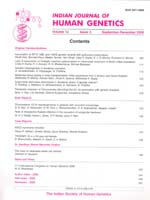
|
Indian Journal of Human Genetics
Medknow Publications on behalf of Indian Society of Human Genetics
ISSN: 0971-6866 EISSN: 1998-362x
Vol. 11, Num. 1, 2005, pp. 49-50
|
Indian Journal of Human Genetics, Vol. 11, No. 1, January-June, 2005, pp. 49-50
Letter To Editor
Cohen syndrome
Kumar T. Sathish, Scott Julius Xavier
Department of Child Health, Christian Medical College,Vellore - 632 004
Correspondence Address: Department of Child Health, Christian Medical College, Vellore - 632 004, Tamil Nadu,
child2@cmcvellore.ac.in
Code Number: hg05010
Sir,
An 11-year-old male boy presented with history of developmental delay. He was born by cesarean section for prolonged labour. There was apparently no birth asphyxia or neonatal morbidity. His birth weight was 2.8 kg. His motor, intellectual and language milestones were delayed since birth. His developmental age is 5 years. On examination, his weight was 44 kg (>95th
centile) and height was 147 cms (<3rd centile). His head circumference was 48 cms. He had hypotonia, microcephaly, open mouth and prominent central incisors. He also had narrow palate, bilateral genu valgum, hypertelorism and narrow hands, high nasal bridge, malar hypoplasia
[Figure - 1]. He also had slender hands with thin tapered fingers
[Figure - 2]. Ophthalmic examination revealed high myopia with no retinal changes. He was diagnosed to have Cohen syndrome in view of obesity, hypotonia, mental retardation, prominent central incisors and narrow hands with tapered fingers and eye changes.
In 1973, Cohen[1] and his associates reported a new syndrome with hypotonia, obesity, mental deficiency and oral, ocular and limb anomalies. Smith subsequently names this as Cohen syndrome. It is an autosomal recessive disorder. Based on findings in their cohort of Finnish patients, Kivitie-Kallio and Norio[2] proposed the following features as essential for the diagnosis of Cohen syndrome: (1) non-progressive mental retardation, motor clumsiness, and microcephaly; (2) typical facial features including wave shaped eyelids, short philtrum, thick hair, and low hairline; (3) childhood hypotonia and joint hyperextensibility; (4) retinochoroidal dystrophy and myopia by 5 years of age; (5) periods of isolated neutropenia.
The diagnosis of Cohen syndrome is often considered within the differential diagnoses of inherited conditions where mental retardation is associated with retinopathy and obesity, for example, Bardet-Biedl, Borjeson-Forssman-Lehmann syndrome and Alstro φm syndromes.[3]
Most patients are born of low birth weight, following a normal pregnancy. Neonatally, significant feeding difficulties and hypotonia are frequent problems. Global developmental delay is seen in all patients. Delayed motor milestones and clumsiness are compounded by hypotonia and joint laxity. Speech delay is universal and often severe, but many patients achieve reasonable communication by the age of 8 years. Progressive visual disability is a significant problem for Cohen syndrome patients. A truncal distribution of fat is consistently seen in the over 8 year olds but true obesity is uncommon. Pubertal development is often delayed. Generalised and marked joint laxity is frequent in Cohen syndrome, affecting particularly the hands, feet, and knees. The patients′ general health is usually good and, despite being neutropenic, severe infections and hospitalisation are rare. Patients continue to live at home or in residential care in their adult life and require supervision for many daily living skills.[4] Accurate diagnosis on clinical features favors genetic counseling.
REFERENCES
| 1. | Cohen MM Jr, Hall BD, Smith DW, Graham CB, Lampert KJ. A new syndrome with hypotonia, obesity, mental deficiency and facial, oral, ocular and limb anomalies. J Pediatr 1973;83:280-4. Back to cited text no. 1 |
| 2. | Kivitie-Kallio S, Norio R. Cohen syndrome: Essential features, natural history, and heterogeneity. Am J Med Genet 2001;102:125-35. Back to cited text no. 2 |
| 3. | Cantani A, Bellioni P, Bamonte G, Salvinelli F, Bamonte MT. Seven hereditary syndromes with pigmentary retinopathy. Clin Pediatr 1985;24:578-83. Back to cited text no. 3 |
| 4. | Chandler KE, Kidd A, Al-Gazali L, Kolehmainen J, Lehesjoki A-E, Black GCM, et al. Diagnostic criteria, clinical characteristics, and natural history of Cohen syndrome. J Med Genet 2003;40:233-41. Back to cited text no. 4 |
Copyright 2005 - Indian Journal of Human Genetics
The following images related to this document are available:
Photo images
[hg05010f2.jpg]
[hg05010f1.jpg]
|
